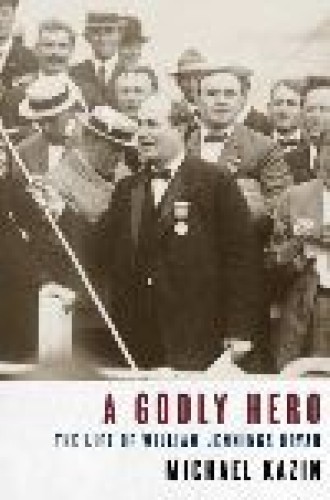Evangelical reformer
Michael Kazin, a scholar of U.S. populism who catalogues William Jennings Bryan’s many public incarnations, chose to write about the Great Commoner for several related reasons.
First, as a historian Kazin sees Bryan—partisan of white farmers and laborers, thrice-defeated presidential candidate, secretary of state under Woodrow Wilson, crusader for temperance and women’s suffrage—as an innovator whose approach to political campaigning shaped politics today. Kazin finds the roots of our contemporary obsessions with candidates’ personalities in Bryan’s style on the stump. The grassroots network that revered and promoted Bryan’s various initiatives helped transform the act of voting from a dispassionately performed duty to a highly personalized activity built around testing and selecting worthy servants.
Kazin traces many now-routine candidate behaviors back to Bryan. In 1896 and again in 1900, Bryan hit the campaign trail on his own behalf, breaking with the tradition of parties stumping for decorously low-profile candidates; in 1905, he made a “publicity-soaked” world tour, an unprecedented move for an American politician in “the prime of his career”; in 1908, exploiting Thomas Edison’s invention of the phonograph, he made sound recordings of short campaign messages and sold them through the Victor company.
By detailing Bryan’s charisma and tremendous energy, Kazin attempts to rescue this innovative leader from what E. P. Thompson called “the enormous condescension of posterity,” largely the result of Bryan’s involvement in the 1925 Scopes case, H. L. Mencken’s coverage of the proceedings, and the loose dramatization of the trial in the 1955 play Inherit the Wind. Bryan’s post-Scopes image as a benighted fundamentalist has prevented subsequent generations from understanding how he drew together reformist factions that seem incongruous to us today.
Kazin’s second aim in writing this narrative is to show Bryan as a product of mainstream 19th-century evangelical social reform, which used the Bible to champion many progressive programs on behalf of children and wage-earning men and women. This picture of Bryan reveals not a militant antimodernist who condemned and withdrew from the urbanizing world, but a man deeply engaged in creating policy solutions to address economic problems. Bryan gained his enormous popular following not by shunning modernity but by adapting some of its methods and by tempering some of its impulses with a folksy, Bible-steeped rhetoric of democratic communitarianism.
Kazin’s extensive and careful stroll through Bryan’s political life does not always make for exciting reading, but the amount of political-insider detail may be essential to Kazin’s project of lifting Bryan out of the wasteland to which history has consigned him. Kazin painstakingly recounts Bryan’s movement from successful lawyer in Lincoln, Nebraska, to member of the Wilson cabinet to subject of Clarence Darrow’s cross-examination in Dayton, Tennessee. The Great Commoner comes off not as the consummate strategist—although he certainly did his share of strategizing—but as a politician primarily, even obsessively, concerned with speaking out on economic issues that vexed white American farmers and workers. (Bryan held conventional turn-of-the-century views on race and gingerly sidestepped the occasional political endorsement that came his way from black voters.)
Like that of many reformers of his day, Bryan’s progressivism grew from his understanding of the biblical ideals of equality, community, justice and hospitality, rather than from secular ideological or philosophical commitments. In fact, Bryan’s understanding of the Bible, revealed for better or worse in the Scopes trial, sets him apart from fundamentalist literalists. As Kazin notes, Bryan always acted from a sense of religious pragmatism, eager to defend the Bible’s indispensable role as a moral guide for human civilization rather than its accuracy as a historical text. Bryan’s argument with Darwinism arose precisely from his concern that the idea that nature asserts strength over weakness would leave intact the unjust, money-soaked and scandal-ridden economic and political order of his day.
A final motive for writing this book emerges from Kazin’s own identity as a public intellectual who has written for Mother Jones and the Nation and who has his own notions of the good society. Other biographers have tackled Bryan before, most notably Paolo Coletta in a multivolume work (1964, 1969); Lawrence Levine, who studied the last ten years of Bryan’s life (1965); and Louis Koenig, who produced a “political biography” (1971). Kazin finds Bryan’s tradition-rooted reformism relevant to our cultural moment. He has attempted to enlarge and correct Bryan’s image in the hope that readers will come away with a genuine respect for Bryan’s grassroots religious pragmatism.
If Bryan’s best ideas are applied to the issues of racial justice that Bryan himself ignored, in Kazin’s hands the Great Commoner could become a model for religious liberals who are trying to reinvigorate public God-talk on the left: “Any revival of a religious left,” Kazin advises, “must begin from the premise that one’s fellow Americans of the lower and middle classes are brothers and sisters whose well-being ought to be the main goal of political activism.” This is the kind of talk that Bryan excelled in, at least when he spoke on behalf of his white brothers and sisters. Drawing on his understanding of biblical principles, Bryan envisioned a radically democratic nation characterized by just social relations, agrarian values and antimilitarism. Kazin hopes that his readers will catch Bryan’s vision in a political age when Christian values have been much invoked in the pursuit of different ends.






